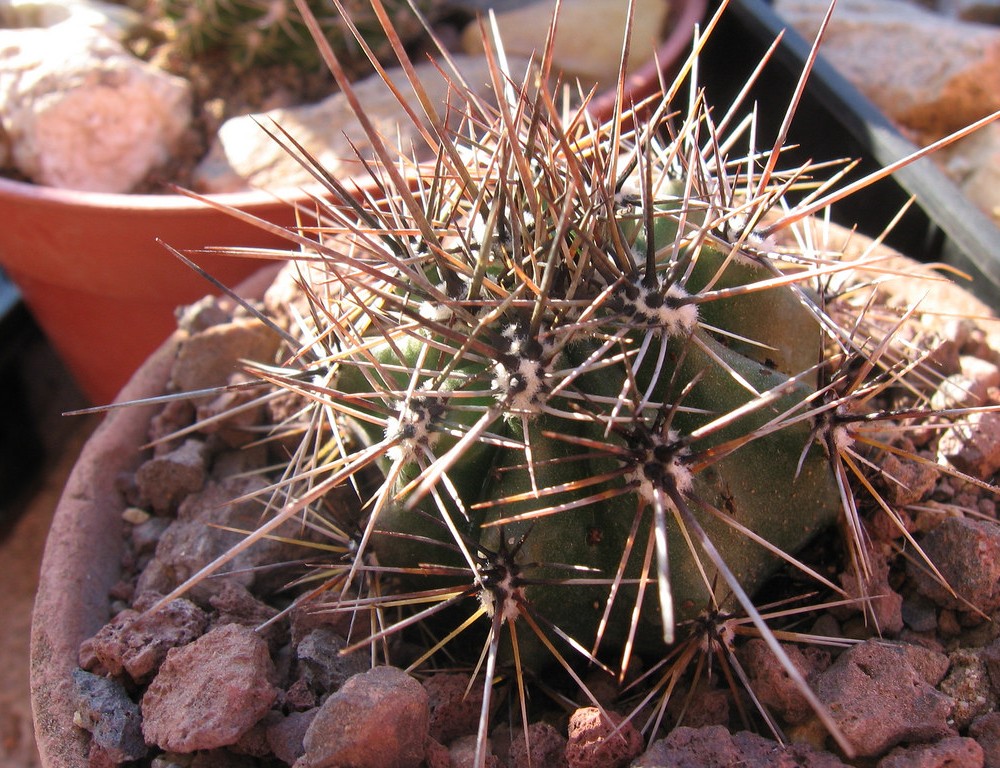Chilean golden ball
(Eriosyce chilensis)

Description
Eriosyce chilensis is a species of cactus in the family Cactaceae, native to the Andes of central Chile. It is commonly known as the "Chilean golden ball" due to its spherical shape and bright golden-yellow spines. In this article, we will explore the taxonomy, morphology, habitat, and cultivation of this fascinating cactus species. Taxonomy Eriosyce chilensis was first described by the German botanist Friedrich Ritter in 1962. It belongs to the genus Eriosyce, which is comprised of about 70 species of cacti native to South America. The genus is characterized by its small to medium-sized globular or cylindrical bodies, its woolly areoles bearing spines, and its bright-colored flowers. Morphology Eriosyce chilensis is a small, globular cactus that can grow up to 6 inches (15 cm) tall and 8 inches (20 cm) in diameter. It has numerous ribs that are covered in dense white wool and spines that are golden-yellow in color. The spines are needle-like, and their length varies between 0.2 to 1.2 inches (0.5 to 3 cm). The flowers of Eriosyce chilensis are bright magenta or purple and appear at the top of the cactus. They are about 1.2 inches (3 cm) in diameter and bloom in the summer. Habitat Eriosyce chilensis is native to the Andes of central Chile, where it grows at elevations between 3,600 and 6,600 feet (1,100 to 2,000 meters). It prefers rocky slopes and soils that are well-draining and rich in minerals. The climate in this region is dry and arid, with temperatures ranging between 50°F to 80°F (10°C to 27°C) during the day and dropping to freezing temperatures at night. Cultivation Eriosyce chilensis is a popular cactus among collectors due to its unique shape and striking appearance. It is relatively easy to cultivate, but it requires well-draining soil and a warm, dry climate. The cactus should be grown in a container with drainage holes, using a mix of cactus soil and coarse sand or perlite. Watering should be done sparingly, allowing the soil to dry out completely before watering again. During the winter months, the cactus should be kept dry and protected from frost. Propagation Eriosyce chilensis can be propagated from seed or by grafting onto another cactus species. To propagate from seed, sow the seeds in a well-draining soil mix, and keep them moist until they germinate. Once the seedlings are established, they can be transplanted into individual containers. To graft, select a healthy rootstock and a scion from a mature Eriosyce chilensis plant. Make a clean cut on both the rootstock and scion, and join them together using grafting tape or a rubber band. Keep the grafting area dry and protected from direct sunlight until the graft has fully taken. Conclusion Eriosyce chilensis is a unique and beautiful cactus species that is easy to cultivate and propagate. It is a popular choice among collectors due to its striking appearance and relative ease of care. Its golden-yellow spines and bright magenta or purple flowers make it a standout in any collection. With proper care and attention, Eriosyce chilensis can thrive for many years, bringing joy and beauty to any garden or collection.
Taxonomic tree:







